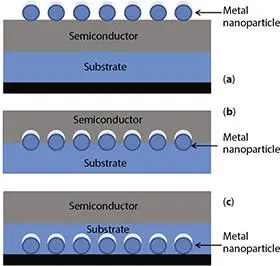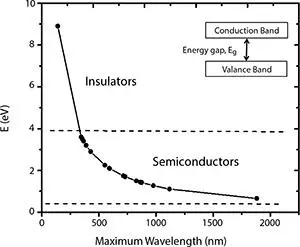
Figure 2.4 Approaches to integrate plasmonic nanoparticle in solar cell.
Plasmonic nanostructures can be used mainly in three manners. First, they can be positioned at the top surface as subwavelength scattering element in solar cell as shown in Figure 2.4a. The metallic nanoparticles dielectric particles are used to get scattering. Metallic nanoparticles are preferred because they can scatter more light than their geometry area. Second, a plasmonic nanostructure can be embedded at the interface or inside the absorber as shown in Figure 2.4b. The plasmonic resonance scatters the light inside the absorber layer and increases absorption at the interface. This design is more preferred in DSSC and single junction PV device. Third, the metallic nanostructure can be positioned as array of nanoparticle or very thin film at the back surface in solar cell as shown in Figure 2.4c. The light travels in a longer path and enhances the absorption. The plasmonic thin film does the task of light trapping and collection of charge carriers [38–40].
2.3 Important Optical Properties
The plasmonic nanostructures are mainly used for increasing light absorption through scattering in plasmonic solar cells. The plasmonic nanostructures are affecting to optical properties such as light trapping, absorption, scattering, resonance wavelength range, and energy levels.
The metal nanoparticles are normally placed at a particular distance for trapping enough sunlight between nanoparticle and substrate in solar cell. The illuminated light intensity decreases with distance from the substrate in the case of embedded plasmonic nanoparticle. The top deposited plasmonic nanoparticle design is advantageous for illuminated light into the substrate. The more light escapes from device if there is no distance between the substrate and particle. The absorption is enhanced by folding light in absorber using plasmonic nanoparticles. The folding of light is mainly depending on the structural properties of metallic nanoparticles. The absorption is large in small nanoparticles because of increased near-field. However, very smaller metal nanoparticles go through ohmic loss. Hence, the surface plasmons can be utilized to improve the electric and optical behavior of solar cells. SPRs have ability to collect about 95% incident light where as conventional solar cell can collect about 30% of sunlight [41].
2.3.2 Scattering and Absorption of Sunlight
The absorption and scattering of incident sunlight are main affecting parameters on the efficiency of solar cells. The utilization of plasmonic nanostructures at the top surface of the PV device improves the overall absorption through the scattering of light. For example, silicon does not absorb much light and hence more lights need to be scattered to increase the absorption. The deposited silver metal nanoparticles at the surface increases the absorption and scattering due to surface plasmons is about 10 times more than the nanoparticle. A broader plasmon resonance can be achieved in metal nanoparticles with a large scattering [42].
2.3.3 Multiple Energy Levels
The multiple energy levels are possible by designing the stacks of solar cells on top of each cell with a different energy band gap to increase the absorption of light. The stacked structure of PV cell utilizes maximum sunlight and produces maximum energy conversion efficiency. The each cell should have same lattice parameters to decrease the energy losses [43]. The energy band gap values are summarized for various materials with their maximum absorption wavelength in Table 2.2. The band gap energy vs. λ maxcurve for different photoactive materials is shown in Figure 2.5.
Table 2.2 Energy band gap of various absorber and metal nanoparticles.
| Material |
Energy band gap (eV) at 300K |
λmax (λ = hc/E = 1242/E) nm |
| Ge |
0.66 |
1,881 |
| Si |
1.11 |
1,118 |
| InP |
1.27 |
977 |
| CIGS |
1.42 |
874 |
| GaAs |
1.43 |
868 |
| CdTe |
1.44 |
862 |
| CZTS |
1.5 |
828 |
| CuO |
1.7 |
730 |
| CdSe |
1.74 |
714 |
| BiFeO 3 |
2.09 |
594 |
| Fe 2O 3 |
2.1 |
591 |
| GaP |
2.25 |
552 |
| CdS |
2.25 |
552 |
| PbO |
2.9 |
428 |
| TiO 2 |
3.2 |
388 |
| SrTiO 3 |
3.2 |
388 |
| ZnO |
3.4 |
365 |
| SnO 2 |
3.5 |
355 |
| ZnS |
3.6 |
345 |
| SiO 2 |
8.9 |
140 |
2.4 Advancements in Plasmonic Solar Cells
Nanotechnology has huge impact on producing efficient energy conversion devices due to its ability to develop novel materials. There are many experimental reports that confirm the enhancement in light absorption and efficiency because of light scattering from metal nanoparticles in plasmonic solar cells. The plasmonic nanostructures utilize the incident photons with multiple energy values and decrease the loss of photon energies. Researchers are finding the best way to use maximum incident photons for more absorption and high efficiency. The plasmonic solar cells are classified mainly into two categories as direct plasmonic and plasmonicenhanced solar PV cells [44, 45]. The schematic representation of various plasmonic solar cells is shown in Figures 2.6a(direct plasmonic solar cell) and 2.6band 2.6c(plasmonic-enhanced solar cells). The efficiency for various plasmonic solar cell technologies is given in Figure 2.7. The various plasmonic solar cells and its efficiencies are summarized in Table 2.3.

Figure 2.5 Bandgap energy vs. λ maxcurve for various material used in solar cells. The values of this curve that are mentioned correspond to Table 2.2.
2.4.1 Direct Plasmonic Solar Cells
The direct plasmonic solar cells utilize plasmonic nanoparticles as active light absorbers. The hot charge carriers in plasmonic nanoparticles can be produced by excitation of SPR. The hot electrons can be introduced into semiconductor for converting sunlight into electric energy and hot holes can also be injected into a p-type semiconductor. The separation of charge carriers makes possible to use plasmonic nanostructures directly as photo absorbers. The metallic nanoparticles such as Au and Ag offers plasmonic band in visible range that can act as light harvesting antenna. Yocefu Hattori and Jacinto Sa have demonstrated direct plasmonic solar cell using gold surface plasmons [46]. Peafowl solar power company, a spinout company from Uppsala University, Sweden, has started to develop direct plasmonic transparent solar cells for commercial applications. The device configuration of this plasmonic solar cell is similar to traditional thin film PV cell. These plasmonic solar cells were manufactured inexpensively through a printing process at room temperature which can convert the light into electricity under very low light [47–49].

Читать дальше















